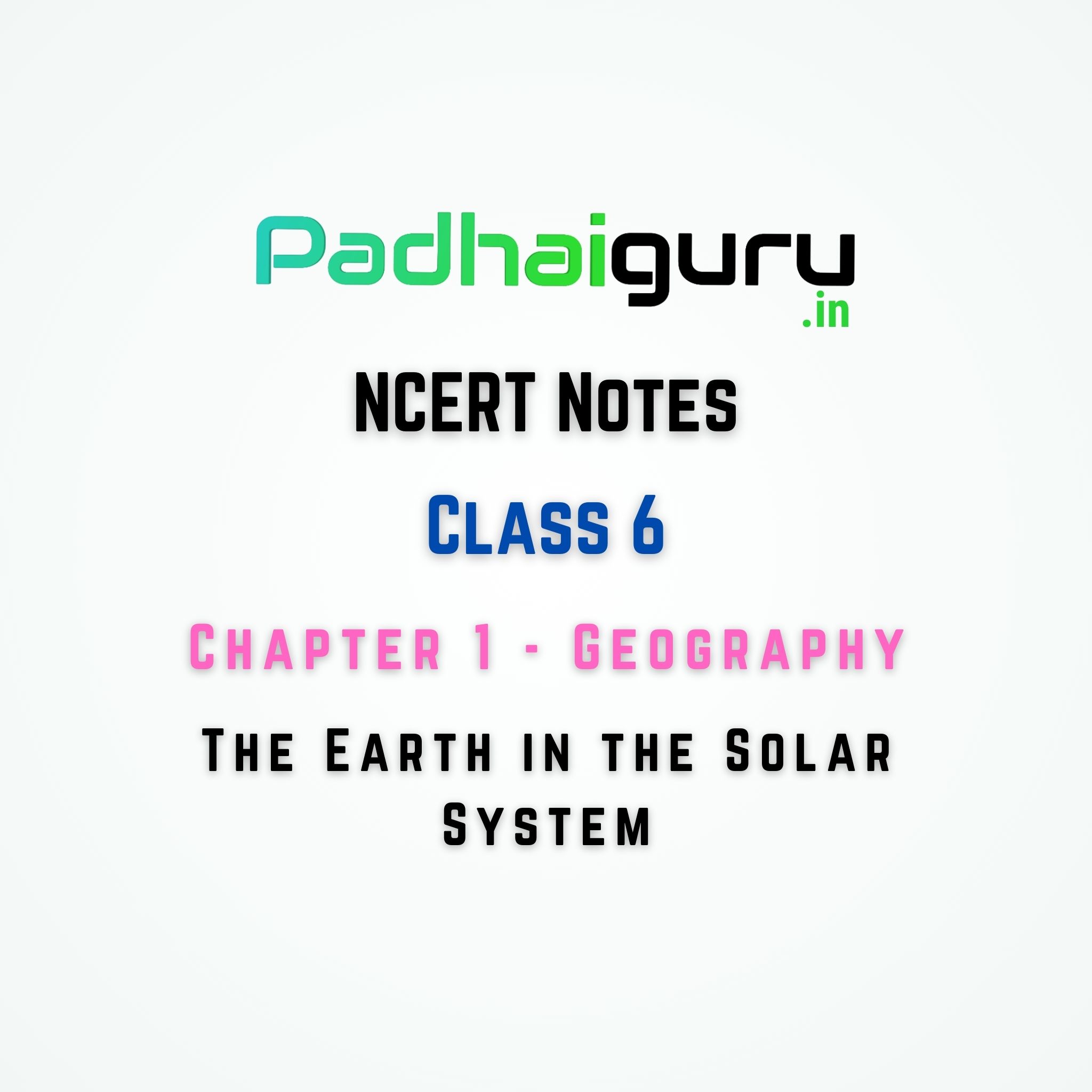01. The Earth in the Solar System Class 6 geography Chapter 1 NCERT Notes CBSE

CBSE NCERT Notes on The Earth in the Solar System Class 6 – Padhaiguru.in
The Earth, positioned as the third celestial body from the Sun, holds a distinct honor as the sole haven for life in the cosmos. As the fifth-largest entity within the solar system, it boasts a unique feature – liquid water on its surface, making it an oasis in space. Among its neighboring planets in close proximity to the Sun, Earth reigns supreme as the largest. Our solar system comprises the magnificent Sun, the gravitational anchor, and a family of celestial companions – Mercury, Venus, Earth, Mars, Jupiter, Saturn, Uranus, and Neptune, alongside the dwarf planet Pluto. This captivating ensemble includes dozens of moons, along with a multitude of asteroids, comets, and meteoroids. For a comprehensive understanding of this fascinating topic, students can access CBSE Class 6 Geography notes for Chapter 1 – The Earth in the Solar System, exclusively on Padhaiguru.in.
In this article, we will explore the fascinating topic of the Earth in the solar system. We’ll break down the information into structured headings and subheadings for easy comprehension. Additionally, we’ll include Wikipedia links for some terms to provide further context.
The Night Sky
Observing the Sky after Sunset
- After sunset, the sky becomes a captivating spectacle.
- Bright dots start to appear, and their numbers increase.
- These celestial objects fill the night sky, resembling twinkling diamonds.
- However, some of them do not twinkle but emit a steady glow, similar to the moon.
The Moon’s Phases
- The moon is a familiar sight in the night sky, but its appearance varies.
- It may appear at different times, in different shapes, and at different positions.
- The full moon, known as Poornima, is visible once a month.
- A fortnight later, during Amavasya, the moon is not visible at all.
Daytime vs. Nighttime Sky
- Bright sunlight during the day obscures celestial objects in the night sky.
- The intense sunlight prevents us from seeing stars and planets.
Celestial Bodies
Introduction to Celestial Bodies
- The sun, the moon, and all objects visible in the night sky are called celestial bodies.
- Some celestial bodies are large, hot, and composed of gases; these are known as stars.
- The sun, our nearest star, fits this description.
Exploring Stars
- Countless stars twinkle in the night sky, similar to the sun.
- However, stars appear tiny because they are incredibly distant from Earth.
- An experiment with a torch and paper can illustrate this concept.
The Earth in the Solar System
Constellations
- Stars in the night sky often form patterns called constellations.
- The Saptarishi, part of Ursa Major, is one easily recognizable constellation.
- The North Star (Pole Star) helps determine the north direction.
Planets
- Planets differ from stars as they do not emit their own heat and light.
- Earth, our home, is one such planet.
- There are eight planets in our solar system, including Earth.
The Unique Earth
- Earth stands out as a planet with favorable conditions for life.
- It maintains a balanced temperature and possesses essential elements like water and oxygen.
- Earth’s blue appearance from space is due to its abundant water.
The Moon
Earth’s Only Satellite
- Earth has one natural satellite, the moon.
- Although relatively small, the moon appears prominent due to its proximity.
- The moon takes about 27 days to orbit Earth, synchronizing with its spin.
Moon’s Surface
- The moon’s surface has various features, including mountains, plains, and depressions.
- Shadows on the moon’s surface cast by these features are observable during a full moon.
Asteroids and Meteoroids
Asteroids
- Asteroids are small celestial bodies found between the orbits of Mars and Jupiter.
- They are believed to be remnants of a planet that broke apart.
Meteoroids
- Meteoroids are small rock fragments that orbit the sun.
- Occasionally, they enter Earth’s atmosphere, creating meteor flashes or even meteorite impacts.
The Vast Universe
The Milky Way Galaxy
- The Milky Way is a vast system of billions of stars, dust, and gases.
- Our solar system is a part of this galaxy.
The Universe
- The universe encompasses all galaxies, stars, and celestial objects.
- Its size is incomprehensible, and scientists continue to explore its mysteries.
Frequently Asked Questions (FAQs)
Q1: How does a planet differ from a star?
Q2: What is meant by the ‘Solar System’?
- The Solar System consists of the sun, planets, satellites, and other celestial bodies orbiting the sun.
Q3: Name all the planets according to their distance from the sun.
Q4: Why is the Earth called a unique planet?
- Earth’s favorable conditions for life, including a balanced temperature, water, and oxygen, make it unique.
Q5: Why do we see only one side of the moon always?
- The moon’s rotation period is the same as its orbital period, causing one side to always face Earth.
Q6: What is the Universe?
- The universe comprises all galaxies, stars, and celestial objects, and its size is vast and largely unknown.
This was the end of NCERT Notes on class 6 Chapter 10 History Buildings Paintings and Books.
For more information, refer to NCERT SOLUTIONS, NCERT NOTES, and NCERT BOOKS
